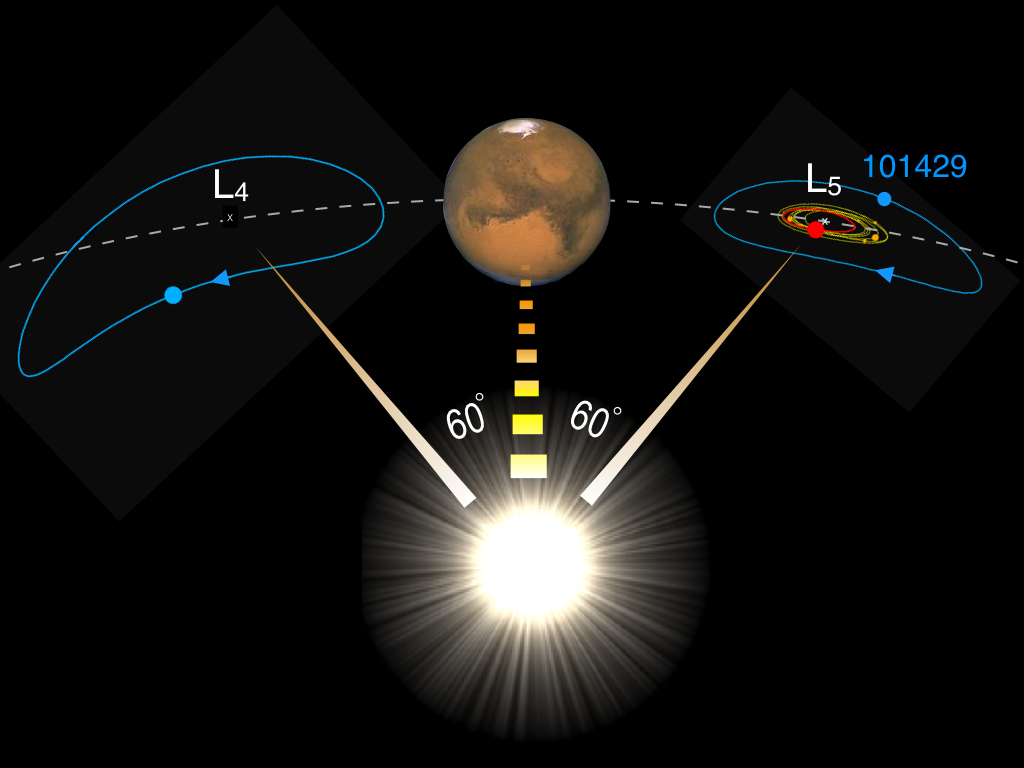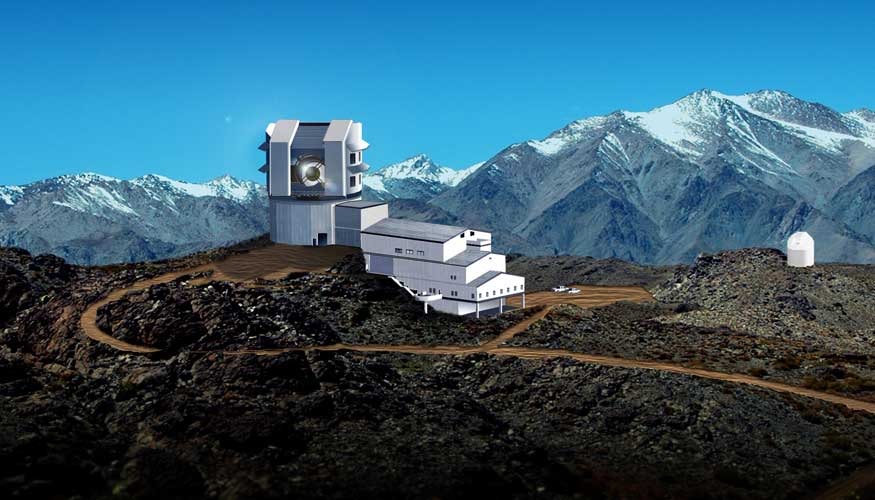From Armagh Observatory and Planetarium (NI)
November 3, 2020
Apostolos Christou
An international team of planetary scientists led by astronomers at AOP have found an asteroid trailing behind Mars with a composition very similar to the Moon’s. The asteroid could be an ancient piece of debris, dating back to the gigantic impacts that formed the Moon and the other rocky planets in our solar system like Mars and the Earth. The research, which was published in the journal Icarus, also has implications for finding such primordial objects associated with our own planet.
Trojans are a class of asteroid that follows the planets in their orbits as a flock of sheep might follow a shepherd, trapped within gravitational “safe havens” 60 degrees in front of, and behind, the planet (Figure 1). They are of great interest to scientists as they represent leftover material from the formation and early evolution of the solar system. Several thousands of those Trojans exist along the orbit of the giant planet Jupiter. Closer to the Sun, astronomers have so far discovered only a handful of Trojans of Mars, the planet next door to Earth.

Depiction of the planet Mars and its retinue of Trojans circling around the L4 and L5 Lagrange points. The dashed curve traces the planet’s orbit. At L5, asteroid 101429 is represented by the blue point, the asteroid Eureka and its family are represented in red and amber respectively.
A team including scientists from Italy, Bulgaria and the US and led by the Armagh Observatory and Planetarium (AOP) (NI) in Northern Ireland has been studying the Trojans of Mars to understand what they tell us about the early history of the inner worlds of our solar system – the so-called terrestrial planets – but also to inform searches for Trojans of the Earth. Ironically, it is much easier to find Trojans of Mars than for our own planet because these Earth Trojans, if they exist, sit always close to the Sun in the sky where it is difficult to point a telescope. An Earth Trojan, named 2010 TK7, was found a decade ago by NASA’s WISE space telescope, but computer modelling showed it is a temporary visitor from the belt of asteroids between Mars and Jupiter rather than a relic planetesimal from the Earth’s formation.

To find out the composition of the Mars Trojans, the team used X-SHOOTER, a spectrograph mounted on the European Southern Observatory 8-m Very Large Telescope (VLT) in Chile.


•KUEYEN (UT2; The Moon ),
•MELIPAL (UT3; The Southern Cross ), and
•YEPUN (UT4; Venus – as evening star).
elevation 2,635 m (8,645 ft) from above Credit J.L. Dauvergne & G. Hüdepohl atacama photo.
X-SHOOTER looks at how the surface of the asteroid reflects sunlight of different colours – its reflectance spectrum. By performing a spectral comparison with other solar system bodies with known composition, a process called taxonomy, the team hoped to determine if this asteroid is made by material similar to the rocky planets like the Earth, or if it is a piece of carbon- and water-rich matter typical of the outer solar system beyond Jupiter.
One on the Trojans the team looked at was asteroid (101429) 1998 VF31. Existing colour data on the object suggested a composition similar to a common class of meteorites called ordinary chondrites. The light-collecting power of the VLT allowed to gather higher-quality data on this asteroid than ever before. By combining these new measurements with data obtained previously at NASA’s Infrared Telescope Facility in Hawaii, the team then tried to classify 101429. They found that the spectrum did not match well with any particular type of meteorite or asteroid and, as a result, expanded their analysis to include spectra from other types of surfaces.
To their surprise, they found (Figure 2) that the best spectral match was not with other small bodies but with our nearest neighbour, the Moon. As Dr Galin Borisov, a PDRA at AOP who was deeply involved in the spectral analysis explains: “Many of the spectra we have for asteroids are not very different from the Moon but when you look closely there are important differences, for example the shape and depth of broad spectral absorptions at wavelengths of 1 and 2 microns. However, the spectrum of this particular asteroid seems to be almost a dead-ringer for parts of the Moon where there is exposed bedrock such as crater interiors and mountains”.

Reflectance spectrum of asteroid 101429 from data obtained at the European Southern Observatory Very Large Telescope in Chile [above] and the NASA Infrared Telescope Facility in Hawaii.

This is plotted against a spectrum of an area around Littrow crater near the Apollo 17 landing site on the Moon obtained from the Mauna Kea Observatory in Hawaii.
Where could such an unusual object have come from? One possibility is that 101429 is just another asteroid, similar perhaps to ordinary chondrite meteorites, that acquired its lunar-like appearance through aeons of exposure to solar radiation, a process called space weathering.
Alternatively, the asteroid may look like the Moon because it does come from the Moon. Dr Apostolos Christou, AOP astronomer and lead author of the paper explains: “The early solar system was very different from the place we see today. The space between the newly-formed planets was full of debris and collisions were commonplace. Large asteroids – we call these planetesimals – were constantly hitting the Moon and the other planets. A shard from such a collision could have reached the orbit of Mars when the planet was still forming and was trapped in its Trojan clouds.”
A third, and perhaps more likely scenario is that the object came from Mars itself. As Dr Christou points out, “The shape of the 101429 spectrum tells us that it is rich in pyroxene, a mineral found in the outer layer or crust of planet-sized bodies. Mars, like the Moon and the Earth, was pummeled by impacts early in its history, one of these was responsible for the gigantic Borealis basin, a crater as wide as the planet itself. Such a colossal impact could easily have sent 101429 on its way to the planet’s L5 Lagrangian point.” Indeed, a Mars origin was proposed a few years ago for 101429’s Trojan siblings, a cluster of Trojans collectively known as the Eureka family (Figure 1). These asteroids also have an unusual composition but, whereas 101429 is pyroxene-rich these Eureka family asteroids are mostly olivine, a mineral found deep in a planetary mantle.
101429 and its brethren also have something to teach us about finding the Earth Trojans, if they exist. Previous work by the team had shown that solar radiation causes debris, in the form of boulder- or city-block-sized chunks, from these asteroids to slowly leak out of the Trojan clouds of Mars. If the Earth Trojans are anything like Mars’s, the same mechanism would act as a source of small near-Earth asteroids that will stand out because of their uncommon composition.
Finding these objects might turn out to be a job for the Vera C. Rubin Observatory, poised to begin the most ambitious survey of the solar system to-date.

Rubin is expected to discover roughly ten times as many asteroids as currently known and, along with the GAIA satellite already surveying the sky from the L2 Earth-Sun Lagrange point, may offer us the best near-term prospects for tracking down the debris of Earth’s Trojan companions.
See the full article here.
five-ways-keep-your-child-safe-school-shootings
Please help promote STEM in your local schools.

Armagh Planetarium is a planetarium located in Armagh, Northern Ireland close to the city centre and neighbouring Armagh Observatory in approximately fourteen acres of landscaped grounds known as the Armagh Astropark.
Armagh Planetarium was established by the seventh director of Armagh Observatory, Dr. Eric Mervyn Lindsay, who, after twenty-five years of effort, secured funding from local councils and the Ministry of Commerce of Northern Ireland in 1965. In the same year Patrick Moore was appointed as Director of the Planetarium to oversee its construction. The planetarium cost £120,000 to build (included in this was £12,000 for the planetarium’s first projector) and was officially opened on 1 May 1968, although it had been open to the public for some months before that. Since then it has undergone many alterations: the main building was extended in 1974 to incorporate the Lindsay Hall of Astronomy, and a dome was created to house a 16″ (400 mm) reflecting telescope for public use, currently the largest public telescope in Ireland. In addition, in 1994 a new exhibition hall, the Eartharium, was added due to increased interest in Earth Science. The Armagh Astropark, which opened in 1994, is a scale model of the solar system and the Universe contained in the grounds of the Armagh Observatory, with scale-sized stainless steel models of the Sun and planets.
In 1968, the Planetarium was founded, and it celebrated its 50th anniversary in 2018.
Under the directorship of Terence Murtagh in the 1970s, Armagh Planetarium introduced many new technologies. Murtagh recognised the possibility of exploiting the new technology of video projectors to provide the show’s special effects, eliminating entirely the need for dozens of slide projectors. Video tape recorders were very new and rare at this time and this research was very ambitious with many technical hurdles standing in the way. Off-the-shelf video projectors had to be optically and electronically modified to present natural-looking images of celestial bodies on the dome. The system he introduced remained in place until computer controlled laserdisc players replaced the videotape players in the 1980s. This development was a great success and Armagh Planetarium was the first planetarium in the world to project video on its dome. Other planetaria around the world followed this lead.
Armagh Planetarium pioneered the introduction of an electronic audience participation system. This allowed the audience to control the show themselves. Each seat was fitted with a small keypad, using this device the audience could use their buttons to respond to multiple-choice quizzes in the show, be polled on their preferences and even steer the direction of the show by selecting the topics. Space Odyssey, created in Armagh in the 1980s and scripted by Ian Ridpath, was the world’s first ever completely interactive planetarium show. This innovation has spread to planetaria worldwide.
Before reopening on 31 July 2006, Armagh Planetarium underwent a major refurbishment. The building was totally refurbished to make it more comfortable and environmentally friendly. These improvements saw the complete rebuilding of the Digital Theatre to accommodate 93 visitors and the installation of a new Bose Corporation stereo sound system, an advanced LED lighting suite and a Digistar 3 fulldome video projection system.
Armagh Planetarium maintains an outreach programme. Planetarium staff travel to venues such as schools and science festivals to deliver presentations on astronomy and other sciences. A thirty-seat inflatable planetarium is used for most of these visits.
On 7 December 2006, the Armagh Planetarium building was dedicated to the memory of Eric Lindsay in a ceremony led by Archbishop Robin Eames.

